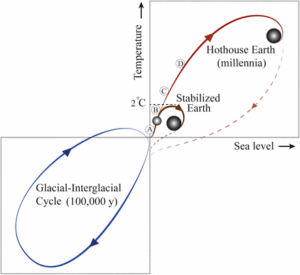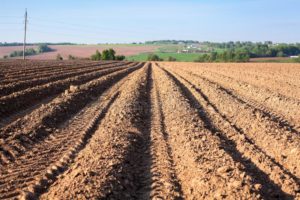Aug
10
2018
 I’ve had a few posts this week that could come off as pessimistic – but there is an upside to these stories. It is true that we don’t currently have enough arable land to feed the world with the USDA recommended diet. We need to continue to improve the efficiency of production and reduce waste. The silver lining is that we have the technology to do this, if we invest in that technology (genetically modifying our crops to have desirable traits) and push back hard against those greenies who are misguided and the organic industry who are trying to demonize a perfectly safe technology.
I’ve had a few posts this week that could come off as pessimistic – but there is an upside to these stories. It is true that we don’t currently have enough arable land to feed the world with the USDA recommended diet. We need to continue to improve the efficiency of production and reduce waste. The silver lining is that we have the technology to do this, if we invest in that technology (genetically modifying our crops to have desirable traits) and push back hard against those greenies who are misguided and the organic industry who are trying to demonize a perfectly safe technology.
It is also true that human-caused global warming is happening, we are already seeing negative consequences, and we may be getting close to a point of no return that could cause disastrous outcomes. The good news is that there are technological solutions, if we prioritize them. While we have been pointlessly debating whether or not global warming is real with closed-minded ideologues, energy technology has been slowly but steadily improving in the background. We could, right now, massively reduce the carbon footprint of our energy infrastructure.
We may be getting to a good tipping point – where clean energy is so much cheaper than fossil fuel based energy that everyone is going to want it. We need to make this tipping point happen faster, and we can if we eliminate fossil fuel subsidies (including the subsidy of not charging for the externalized health and environmental cost of pollution).
One technology that offers the hope of a green tipping point is organic solar cells. These are photovoltaic cells (OPV) that are based mainly on carbon rather than silicon. Silicon produces more efficient solar panels, but they are rigid and heavy. Organic photovoltaics can be dissolved in ink and then printed on cheap flexible plastic or other material. You end up with a light, flexible, and cheap solar cell.
Continue Reading »
Aug
09
2018
 It’s now pretty clear that as we increase global CO2 levels in the atmosphere, mainly by burning stuff, global average temperatures have been increasing as well. This is predicted based upon the greenhouse effect of CO2 and other gases like methane, amplified by reactive gases like water vapor. The amount of warming that results from a given CO2 increase is called climate sensitivity (specifically the rise in average global temperature averaged over 20 years resulting from a doubling of atmospheric CO2), and there is some debate about exactly what the climate sensitivity is.
It’s now pretty clear that as we increase global CO2 levels in the atmosphere, mainly by burning stuff, global average temperatures have been increasing as well. This is predicted based upon the greenhouse effect of CO2 and other gases like methane, amplified by reactive gases like water vapor. The amount of warming that results from a given CO2 increase is called climate sensitivity (specifically the rise in average global temperature averaged over 20 years resulting from a doubling of atmospheric CO2), and there is some debate about exactly what the climate sensitivity is.
Without any feedback effects, from just the primary greenhouse effect of CO2 itself, climate sensitivity is about 1 degree C. However, there are feedback effects, meaning that rising temperatures affect the climate in such a way that more warming results. For example, if the polar icecaps reduce in size, they reflect less light back into space, which results in more warming. Current estimates of climate sensitivity are between 2 and 4.5 degrees C.
However, a new paper published in PNAS argues that climate sensitivity is not the only issue when it comes to predicting future climate change due to increased CO2. Those feedback loops do not only affect climate sensitivity – they also affect climate homeostasis. In other words, at any given amount of CO2 in the atmosphere, taking into consideration all the feedbacks in the climate, an equilibrium will be achieved. There are climate cycles around that equilibrium, but that equilibrium determines long term global average temperatures.
So – what we really need to do is determine where the new equilibrium will settle for any given amount of CO2. This requires predicting not only the effect of feedback loops on the climate, but their effect on each other. The authors argue that several feedback mechanisms can act like a domino effect – on feedback will increase temperatures enough to set off another feedback which increases temperature enough to set off yet another feedback. This whole chain has to work itself out before a new equilibrium is reached.
Continue Reading »
Aug
07
2018
 This question comes up frequently in discussions of farming practices – how much arable land is there on the Earth, and how much are we currently using? It is a deceptively difficult question to answer. It’s an important question, because as the population grows, we need to grow more food. We can do this my increasing the amount of food each acre of land can produce, by farming more acres of land, or by producing food without land. But if we expand farming acres, where would those more acres come from?
This question comes up frequently in discussions of farming practices – how much arable land is there on the Earth, and how much are we currently using? It is a deceptively difficult question to answer. It’s an important question, because as the population grows, we need to grow more food. We can do this my increasing the amount of food each acre of land can produce, by farming more acres of land, or by producing food without land. But if we expand farming acres, where would those more acres come from?
Let’s start with the easy question – right now we are using 11% of all the land on Earth for farming (1.5 billion ha out of a total of 13.4 billion). What percentage of the remaining 89% could be used for farming? The answer is – that depends on your definition of arable land. We can take the upper limit of the estimate of remaining arable land, and then explain why use of that land is problematic.
First, “arable” is a continuum, not a dichotomy. Some land can only be used for a very limited number of potential crops. Other land is highly suitable for many different crops. We won’t count land that is not suitable for farming, even though theoretically it could be used with extreme measures. You can grow corn in the desert, if you import all the water.
If we count all potentially arable land, it is estimated that we are currently using 36% of that land for farming. That means that 64%, or 2.7 billion ha, remain. At first this may seem encouraging, that we have lots of farmable land left. But that figure is very deceptive. Let’s dive into that 64%. The fact is we have already “picked the low hanging fruit.” We have used the best farming land for farming. What remains is largely on the low end of the continuum of suitability. If, for example, land can be used only for olive groves, that is considered arable by the above calculation.
Continue Reading »
Aug
06
2018
We’re doing it wrong. We are definitely making an effort to regulate the practice of medicine and sale of health-care products and services to protect the public from fraud and abuse, as we should. But we are doing it wrong, or at least not well enough.
Just one of the many examples is stem-cell quackery, which I have discussed before. Stem cells are an exciting area of research, and the basic technology is advancing significantly. Clinical applications, however, take time, and with a few exceptions we are simply not there yet. We are currently, therefore, in the sweet spot for abuse.
A recent article in the San Francisco Chronicle, called The Merchants of Hope, highlights the problem. The article should have been called The Merchants of False Hope, but otherwise it did a good job of exposing dubious stem cell clinics that have made their way to the US. A decade ago stem cell clinics were popping up in China, India, and other countries with lax regulation, leading to an industry of stem-cell tourism. But now you can find dubious stem cell clinics right here in the US.
Stem cells, for a quick review, are cells that can turn into other types of cells. There are pluripotent stem cells that can turn into several other kinds of cells, such as the cells in your bone marrow that can make different kinds of blood cells. There are also totipotent stem cells that can turn into any kind of cell. Researchers have gotten good at making totipotent stem cells, even out of mature skin cells. This technology holds the promise of treating a long list of conditions by replacing diseased or damaged cells with new ones.
Continue Reading »
Aug
03
2018
 There is a strong scientific consensus that vaccines generally are an effective approach to preventing infectious illness. The vaccine schedule is arguably the most effective and cost effective health promotion intervention ever devised. Vaccines are a public health home-run.
There is a strong scientific consensus that vaccines generally are an effective approach to preventing infectious illness. The vaccine schedule is arguably the most effective and cost effective health promotion intervention ever devised. Vaccines are a public health home-run.
How, then, to explain the anti-vaccine movement? The anti-vaccine movement is based mainly on science-denial and conspiracy theories. This means they spread a lot of misinformation – the bits of misinformation become articles of faith, and any evidence to the contrary is denied or dismissed.
I recently received the following question, which is framed as a sincere question, but I have my suspicions that it may not be:
Have just read your article.
I fully agree that herbal medicines/substances should have full clinical trials but can never find anyone able to refer me to
any clinical trials placebo versus substance to be tested on vaccines.
So wondered if you could help me as you are obviously a man of science.
Would be very grateful as there must have been clinical trials sometime.
Even my Dr draws a blank.
Many thanks
Pam
Pam may simply be the victim of anti-vaccine propaganda, and may simply lack all Google skills, but the phrasing strongly suggests an anti-vaxxer goading a skeptic with a “gotcha” question. Since this is a common anti-vaccine trope, let me dispel it once again.
Continue Reading »
Aug
02
2018
 One of the mantras on this blog is that perception is constructed by complex processes in the brain, not a passive recording of external stimuli. The implications of this are profound – what you see, hear, and taste are influenced by your internal model of the world, and what your other senses are telling you. In real time your brain is comparing your sensory inputs to each other, and to stored memories. It then finds the best match possible and (this is critical) tweaks your perception to more strongly conform to the apparent match.
One of the mantras on this blog is that perception is constructed by complex processes in the brain, not a passive recording of external stimuli. The implications of this are profound – what you see, hear, and taste are influenced by your internal model of the world, and what your other senses are telling you. In real time your brain is comparing your sensory inputs to each other, and to stored memories. It then finds the best match possible and (this is critical) tweaks your perception to more strongly conform to the apparent match.
In a very real sense, believing is seeing.
A new study extends our understanding of this constructive perceptual phenomenon a bit with respect to vision. The question was mainly – where in the brain are these processes happening with respect to vision? The researchers used a standard paradigm called Mooney images, which are black and white images degraded so that they are difficult to interpret. However, when primed with an undegraded grayscale version of the image (called disambiguation), it becomes trivially easy to interpret the Mooney image. The effects of this priming may last from days to indefinitely.
The researchers confirmed this priming effect, and that it is very robust. What this means is that what the subjects saw was determined as much, if not more, by their memories (of the disambiguation image) as by their current visual stimuli. What you remember is as or more important than what you are seeing, at least when what you are seeing is ambiguous.
The new information from this study, however, was what brain activity reflects this process. Here they also confirmed prior research that visual processing is very hierarchical – basic processing occurs at primary visual cortical levels, and then goes up to higher levels where more complexity is added and memory becomes a stronger influence. Specifically the researchers wanted to know if the default-mode network (DMN) was playing any role.
Continue Reading »
 I’ve had a few posts this week that could come off as pessimistic – but there is an upside to these stories. It is true that we don’t currently have enough arable land to feed the world with the USDA recommended diet. We need to continue to improve the efficiency of production and reduce waste. The silver lining is that we have the technology to do this, if we invest in that technology (genetically modifying our crops to have desirable traits) and push back hard against those greenies who are misguided and the organic industry who are trying to demonize a perfectly safe technology.
I’ve had a few posts this week that could come off as pessimistic – but there is an upside to these stories. It is true that we don’t currently have enough arable land to feed the world with the USDA recommended diet. We need to continue to improve the efficiency of production and reduce waste. The silver lining is that we have the technology to do this, if we invest in that technology (genetically modifying our crops to have desirable traits) and push back hard against those greenies who are misguided and the organic industry who are trying to demonize a perfectly safe technology.
 It’s now pretty clear that as we increase global CO2 levels in the atmosphere, mainly by burning stuff, global average temperatures have been increasing as well. This is predicted based upon the greenhouse effect of CO2 and other gases like methane, amplified by reactive gases like water vapor. The amount of warming that results from a given CO2 increase is called
It’s now pretty clear that as we increase global CO2 levels in the atmosphere, mainly by burning stuff, global average temperatures have been increasing as well. This is predicted based upon the greenhouse effect of CO2 and other gases like methane, amplified by reactive gases like water vapor. The amount of warming that results from a given CO2 increase is called  This question comes up frequently in discussions of farming practices – how much arable land is there on the Earth, and how much are we currently using? It is a deceptively difficult question to answer. It’s an important question, because as the population grows, we need to grow more food. We can do this my increasing the amount of food each acre of land can produce, by farming more acres of land, or by producing food without land. But if we expand farming acres, where would those more acres come from?
This question comes up frequently in discussions of farming practices – how much arable land is there on the Earth, and how much are we currently using? It is a deceptively difficult question to answer. It’s an important question, because as the population grows, we need to grow more food. We can do this my increasing the amount of food each acre of land can produce, by farming more acres of land, or by producing food without land. But if we expand farming acres, where would those more acres come from? There is a strong scientific consensus that vaccines generally are an effective approach to preventing infectious illness. The vaccine schedule is arguably the most effective and cost effective health promotion intervention ever devised. Vaccines are a public health home-run.
There is a strong scientific consensus that vaccines generally are an effective approach to preventing infectious illness. The vaccine schedule is arguably the most effective and cost effective health promotion intervention ever devised. Vaccines are a public health home-run. One of the mantras on this blog is that perception is constructed by complex processes in the brain, not a passive recording of external stimuli. The implications of this are profound – what you see, hear, and taste are influenced by your internal model of the world, and what your other senses are telling you. In real time your brain is comparing your sensory inputs to each other, and to stored memories. It then finds the best match possible and (this is critical) tweaks your perception to more strongly conform to the apparent match.
One of the mantras on this blog is that perception is constructed by complex processes in the brain, not a passive recording of external stimuli. The implications of this are profound – what you see, hear, and taste are influenced by your internal model of the world, and what your other senses are telling you. In real time your brain is comparing your sensory inputs to each other, and to stored memories. It then finds the best match possible and (this is critical) tweaks your perception to more strongly conform to the apparent match.




